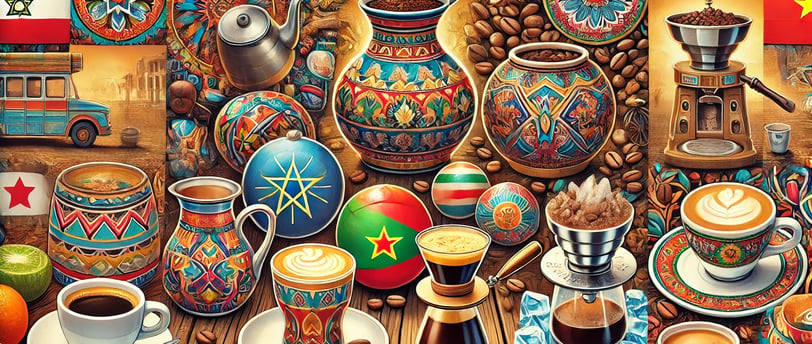Coffee Around the World: Exploring Unique Flavors and Traditions
12/9/20243 min read


Coffee is more than just a drink; it’s a cultural phenomenon that connects people worldwide. Each country has its unique way of brewing, serving, and enjoying coffee, creating rich traditions and diverse flavors. Join us on a journey to discover how coffee is celebrated across the globe.
1. Ethiopia: The Birthplace of Coffee
Ethiopia is often regarded as the birthplace of coffee, and its coffee culture is deeply rooted in tradition. The Ethiopian coffee ceremony is a social and spiritual experience that involves:
Roasting beans: Fresh coffee beans are roasted over an open flame, filling the room with their aromatic fragrance.
Brewing: The coffee is brewed in a clay pot called a jebena.
Serving: The coffee is served in small cups, often accompanied by popcorn or bread.
Ethiopian coffee is known for its floral and fruity flavors, often enjoyed black without sugar.
2. Italy: Home of Espresso
When you think of Italy, espresso likely comes to mind. Italians have mastered the art of making strong, concentrated coffee in small doses. Key aspects of Italian coffee culture include:
Quick stops at cafés: Italians often drink espresso while standing at the bar.
No cappuccinos after 11 a.m.: Italians believe milk-based coffee is only for the morning.
Regional specialties: Variations like the caffè corretto (espresso with a splash of liquor) showcase regional flavors.
Italian coffee emphasizes quality and simplicity, with a focus on rich, bold flavors.
3. Turkey: A Brew Steeped in History
Turkish coffee is famous for its preparation method and role in social customs. Brewed in a small pot called a cezve, Turkish coffee is unfiltered, resulting in a thick, flavorful drink.
Preparation: Finely ground coffee, water, and sugar (optional) are combined and heated until foaming.
Serving: The coffee is poured into small cups, and the grounds settle at the bottom.
Fortune-telling: Reading the coffee grounds left in the cup is a popular tradition.
Turkish coffee is strong and aromatic, often paired with sweet treats like baklava.
4. Japan: Precision and Elegance
In Japan, coffee culture combines meticulous attention to detail with modern innovation. While tea has been the traditional beverage, coffee has gained popularity, especially through unique brewing techniques:
Pour-over mastery: The Hario V60 is a Japanese invention, perfect for crafting clean and delicate coffee.
Siphon brewing: This method resembles a scientific experiment and produces a smooth, flavorful cup.
Café culture: Japan is home to quirky and themed coffee shops that offer unforgettable experiences.
Japanese coffee often highlights subtle and nuanced flavors, reflecting the country’s dedication to craftsmanship.
5. Brazil: A Coffee Giant
As the largest coffee producer in the world, Brazil has a strong coffee culture that revolves around its national drink, cafezinho.
Serving style: Cafezinho is a small, sweet coffee served in tiny cups, often as a gesture of hospitality.
Farm tours: Brazil offers coffee farm tours where visitors can learn about the production process.
Diverse flavors: Brazilian coffee varies from nutty and chocolatey to bright and fruity, depending on the region.
Coffee is an integral part of daily life in Brazil, enjoyed both at home and in bustling cafés.
6. Sweden: The Fika Tradition
In Sweden, coffee is more than a beverage; it’s an opportunity to pause and connect with others through the tradition of fika.
What is fika?: A coffee break accompanied by pastries or sandwiches, often shared with friends or colleagues.
Popular pairings: Swedish cinnamon buns, or kanelbullar, are a favorite companion to coffee.
Social importance: Fika emphasizes slowing down and fostering relationships.
Swedes favor medium-roasted coffee with a smooth and balanced flavor.
7. Vietnam: A Sweet Delight
Vietnamese coffee is renowned for its bold flavors and unique preparation methods. The signature drink, cà phê sữa đá, combines robusta coffee with sweetened condensed milk over ice.
Drip brewing: A phin filter slowly brews the coffee, creating a strong and concentrated flavor.
Egg coffee: In Hanoi, whipped egg yolk, sugar, and condensed milk are added to coffee for a creamy treat.
Street culture: Coffee is often enjoyed on small stools in bustling street cafés.
Vietnamese coffee is bold, rich, and often sweet, offering a delightful contrast to other traditions.
8. Colombia: Coffee with Pride
Colombians take pride in their coffee, which is celebrated for its high quality and smooth flavor. The coffee-growing region, known as the Coffee Triangle, is a UNESCO World Heritage site.
Tinto: A popular style of coffee in Colombia, tinto is a black coffee often served sweetened.
Farm visits: Tourists can explore coffee farms and learn about sustainable practices.
Flavors: Colombian coffee is known for its mild, well-balanced taste with hints of caramel and fruit.
Coffee is not just a drink in Colombia; it’s a symbol of national pride and heritage.
The Global Coffee Experience
Coffee traditions worldwide highlight the cultural diversity and creativity surrounding this beloved drink. From Ethiopia’s ceremonial roots to Japan’s precision brewing, each country adds its unique flavor to the coffee experience.
Exploring these traditions not only broadens your palate but also deepens your appreciation for the role coffee plays in connecting people across borders. So, next time you enjoy your coffee, think about the global journey it represents.
